The Reading Chair: November 2019

You are here
New children’s books too good to miss and one forever favorite
My Tooth Is LOST!: A Monkey & Cake Book
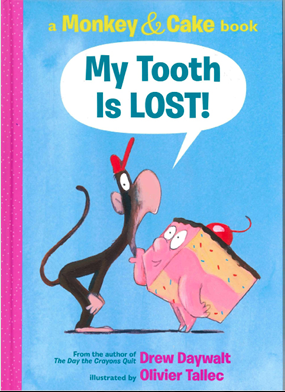 By Drew Daywalt. Illus. by Olivier Tallec. 2019.
By Drew Daywalt. Illus. by Olivier Tallec. 2019.
New York: Orchard Books. 56 pp. Ages 3 to 7.
In this absurd and humorous story about friendship (part of an early reader series), Cake helps its good friend Monkey understand what it means to lose a tooth. It can be hard to reach this childhood milestone, both physically and emotionally. Yet in this tale, the magic of the tooth fairy—borne of myths and legends from civilizations throughout history—offers reassurance and delight.
Young children will enjoy the book at story time, and many who are newly toothless will be able to tackle this read on their own. Uncluttered, colorful illustrations are full of expression and feeling. This book comes from the same author as The Day the Crayons Quit.
Trio: The Tale of a Three-Legged Cat
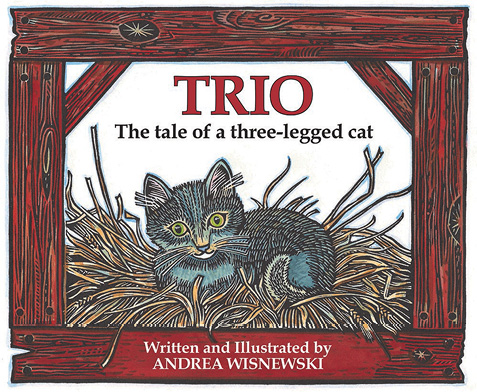 By Andrea Wisnewski. 2017. Boston: David R. Godine. 40 pp. Ages 3 to 7.
By Andrea Wisnewski. 2017. Boston: David R. Godine. 40 pp. Ages 3 to 7.
Trio was born into a litter of four kittens. He has three legs—unlike his siblings who have four—but he doesn’t feel any different. Some things are more challenging for him, but Trio finds a way. He even keeps up with the chickens. Trio’s curiosity and imagination get him into all sorts of trouble and fun. But one thing Trio can’t do is lay an egg. Or can he? With Trio’s drive and can-do attitude, he lives a full life.
The book’s illustrations are made from beautiful woodcuts. The charming and uncluttered designs pop off the page. Based on a true story.
Mother Goose of Pudding Lane
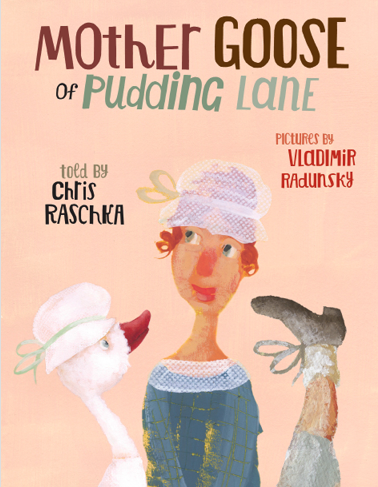 By Chris Raschka. Illus. by Vladimir Radunsky. 2019. Somerville, MA: Candlewick. 48 pp. Ages 2 to 8.
By Chris Raschka. Illus. by Vladimir Radunsky. 2019. Somerville, MA: Candlewick. 48 pp. Ages 2 to 8.
Mother Goose has endured for over 300 years, providing entertainment and highlighting the value of rhyme, rhythm, pacing, predictive text, and rich vocabulary. Mother Goose’s rhymes give realistic takes on everyday life. They promote young children’s literacy skills and provide a common bond to readers who recite them together.
Mother Goose feels timeless, but a fresh interpretation is always a pleasure. Here, award-winning author and artist Chris Raschka presents the rhymes within the life story of one of their fabled creators, Elizabeth Goose, a mother and stepmother of 14 children in the 1600s.
Vladimir Radunsky’s illustrations offer much more than the quaint “polite girls in bonnets” we tend to see in Mother Goose tomes. Radunsky’s playful and punchy pictures are true to the period (the dress, the architecture), yet contemporary and fun.
Now You Know What You Eat
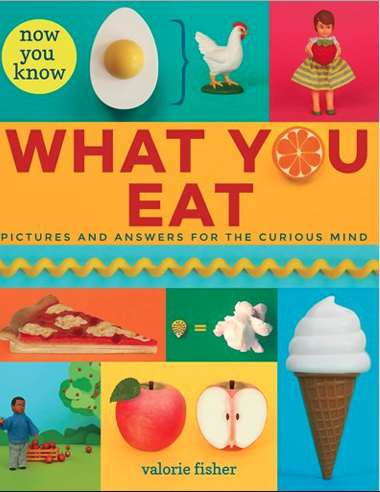 By Valorie Fisher. 2019. New York: Orchard Books. 40 pp. Ages 3 to 8.
By Valorie Fisher. 2019. New York: Orchard Books. 40 pp. Ages 3 to 8.
This ingenious food science book for children is a feast. If readers ever wondered how their favorite foods are made—from ice cream to dill pickles to maple syrup to mac and cheese—this book has the answers. Each food’s origin story is presented through clean and appealing graphics that blend recipes and mathematics. Each page offers something unexpected: the various animals all over the world that are relied on for milk, the scientific process through which corn kernels pop, and the way cacao beans become a bar of chocolate.
By learning how foods are processed and created, children will be able to make better informed choices about what to eat. At the end of the book, readers see how to apportion foods on their plates to make a balanced meal. They learn which foods contain which vitamins and minerals, and which of those provide a boost to various parts of the body such as the eyes, muscles, and heart. A “Words to Know” section at the back covers terms from bacteria to curdle to pollination. Young readers will want to pour their attention into this visually delightful, chock-full food book.
Can You Eat?
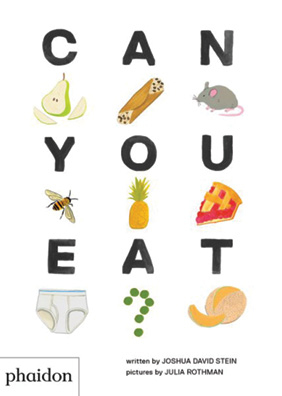 By Joshua David Stein. Illus. by Julia Rothman. 2019. New York: Phaidon. 30 pp. Ages birth to 4.
By Joshua David Stein. Illus. by Julia Rothman. 2019. New York: Phaidon. 30 pp. Ages birth to 4.
This board book asks which items are edible and which are not, delighting readers with unexpected mash-ups (chocolate mousse, Alaskan moose) and playful rhymes (éclair, high chair). It presents an excellent array of vocabulary words and international foods in a format that makes an enjoyable point-and-say book for the very young. Older readers will appreciate the wordplay and humor too. The gouache artwork is light and bright (imagine key lime, prickly pear, and orange sherbet), and the objects are clear and appealing.
Forever Favorites
In each issue we feature a classic book to (re)introduce teachers to old favorites.
This time, it comes with a new title too.
Don’t Let the Pigeon Drive the Bus!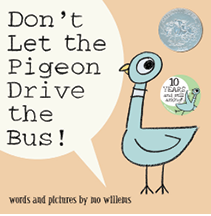
By Mo Willems. 2003. New York: Hyperion Books for Children. 40 pp. Ages 2 to 5.
The Pigeon HAS to Go to School!
By Mo Willems. 2019. New York: Hyperion Books for Children. 40 pp. Ages 2 to 6.
Mo Willems’ Pigeon is our favorite obstinate toddler. Originally published over 15 years ago, Don’t Let the Pigeon Drive the Bus! is a perfect preschool book. Young readers identify with the frustrated pigeon, whose desires to drive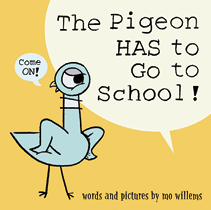 the bus are thwarted by rules. He is an eternal optimist, much like a child. And yet, young readers also delight when his over-the-top antics get him nowhere and the rules remain in force.
the bus are thwarted by rules. He is an eternal optimist, much like a child. And yet, young readers also delight when his over-the-top antics get him nowhere and the rules remain in force.
The brand new The Pigeon HAS to Go to School! has the same rhythm and outrageousness as its predecessor. But this time, the drama focuses on Pigeon’s fear of school. This book has new depth, for Pigeon isn’t just frustrated; he’s scared. Willems shows incredible emotion and attitude in very few lines of text. He taps into children’s vulnerabilities, but for all the tension he creates, he diffuses it with humor. In a light moment at the end, Pigeon finds something to love: the yellow bus that comes to pick him up. Vehicle-obsessed preschoolers intuitively understand what a rewarding twist this is. For those who know the original book, the ending will be that much funnier.




Isabel Baker, MAT, MLS, is the founding director of The Book Vine for Children, a national company dedicated to getting good books into the hands of preschool children and their teachers. Isabel has worked as a children’s librarian and is currently a presenter on early literacy and book selection.
Miriam Baker Schiffer, MFA, is a writer in Brooklyn, New York. She consults on book selections for The Book Vine, in McHenry, Illinois. Miriam’s children’s book, Stella Brings the Family, was published by Chronicle Books in 2015.
